(Written by William)
The #21323 LEGO Ideas Grand Piano was released some time back, but because the initial batch ran out almost immediately, it has been hard to find until just recently. And by the time it did get back in stock, we were inundated with other expensive sets for adults. But the piano was actually meant to be one of the early sets designed for adults to help convince us it was a good idea to release such large and pricey sets.
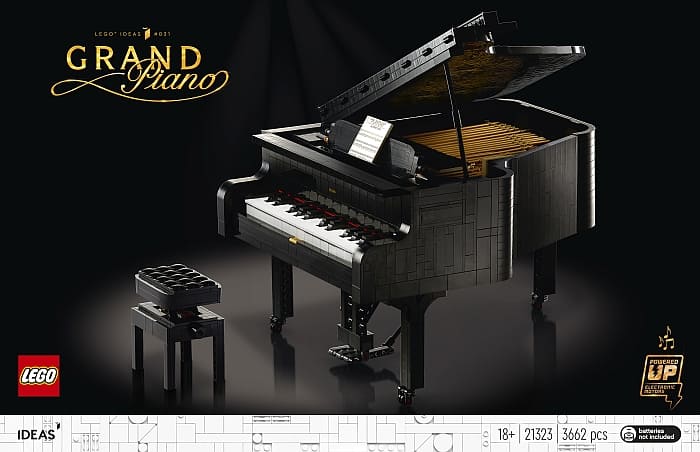
The presentation of the box alone is rather classy. Unlike other sets, the piano features a two-piece box that opens up like a really large board game with a separate lid. Inside the big box is a smaller box – a packaging choice LEGO sometimes uses for large sets to keep the pieces evenly distributed and safe. But while other sets usually have plain white inner boxes, the piano has a black inner box with piano keys printed on it. Overall, it felt rather momentous to unpack all the numbered bags.
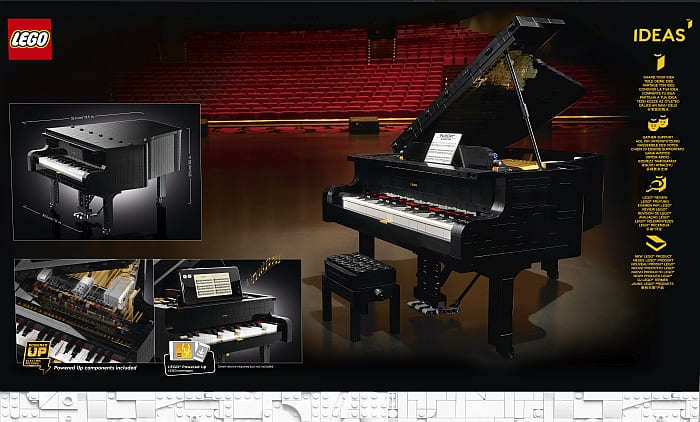
At $350 USD, the piano is a rather large model. I’m pretty sure the price will keep many away and I can see quite a few collectors picking it up but never building it for fear of losing resale value. I myself was struggling with this very fact. Fortunately, my wife expressed interest in it. That was enough for me to surprise her on her birthday with it and we got straight into building.
Putting together models that are a slightly larger scale is still a new experience for me. This meant I was eager to see what types of building methodology I could learn from this set as well as just how in the world this thing worked. I split up these two sections for my review since they feel more like two distinct aspects of this set. I’m hoping you can see my point. Now let’s dig into this model!
LEGO IDEAS GRAND PIANO – BUILDING FUNCTIONALITY
Any time you have a LEGO model of significant size, you have an opportunity to build in two ways. You can increase the amount of detail to an insane level, and you are able to build in increasing amounts of functionality into the model. Given the fact that a grand piano is a fairly recognized shape, there was only one detail I can see that was skipped out on, that being the sheer number of keys typically present on a real grand piano.
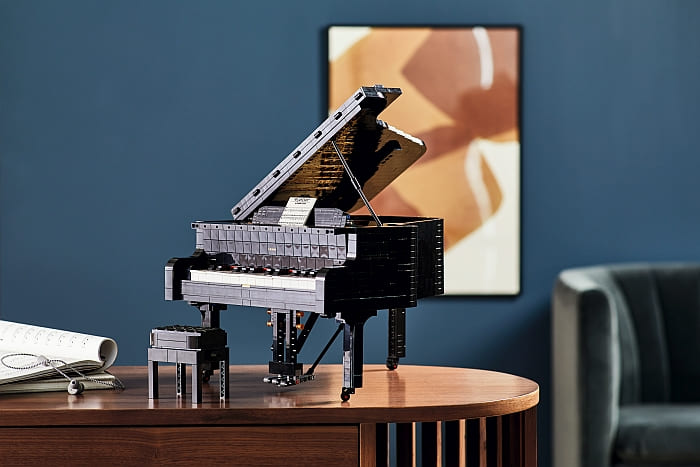
That being said, it is extremely impressive to see that two whole octaves are represented in the keys. For those unfamiliar with what an octave is, it represents a full scale of notes we hear in music. A scale on a piano starts with “C” and goes through, “D, E, F, G, A, and B” before it returns to “C.” When it hits that note, the first and second “C” are said to be an octave apart since it is the eighth note from where you started. Keep in mind I’m leaving out all the sharps and flats, which are the black keys.
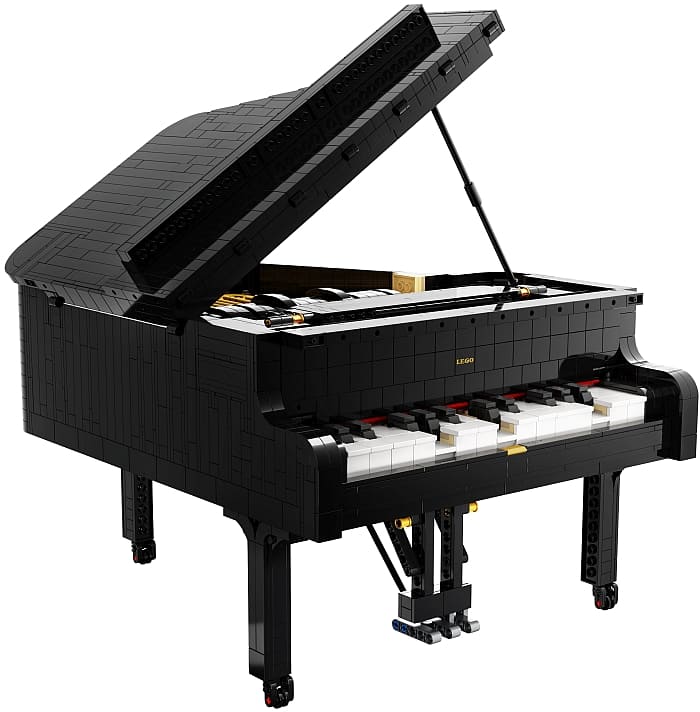
Given the fact that LEGO designers represented something musically significant even in the feature they reduced shows just how dedicated they were to get this model right. Speaking of which, if LEGO designers did that much on detail work then they must have done a lot on the functionality side, right?
And you better believe they added functionality to the piano! Let’s start with how each and every key works. Each key – both black and white – is a lever that pivots on a fulcrum. In this case, the fulcrum is an upside-down ice cream cone. When pressed, it has a modified rounded pinhole plate on top of the key that helps move a hammer. This hammer strikes the bar above it, thus simulating striking piano string. Additionally, the far end of each key also raises a curved structure inside the piano. These curved structures are meant to recreate dampers found in pianos. After a note is played and the piano string vibrates, it is the job of the damper to come back down to silence the note so that tone won’t go on ringing longer than intended.

These dampers are also able to be moved by a foot pedal on the underside of the piano. Pressing this pedal pushes a large hinged bar section under all the baffles allowing all of them to be raised. In real pianos, this is how you can maintain sustained notes without continuously holding down a key. And all of this works together for all twenty-five keys. But LEGO designers didn’t stop there.
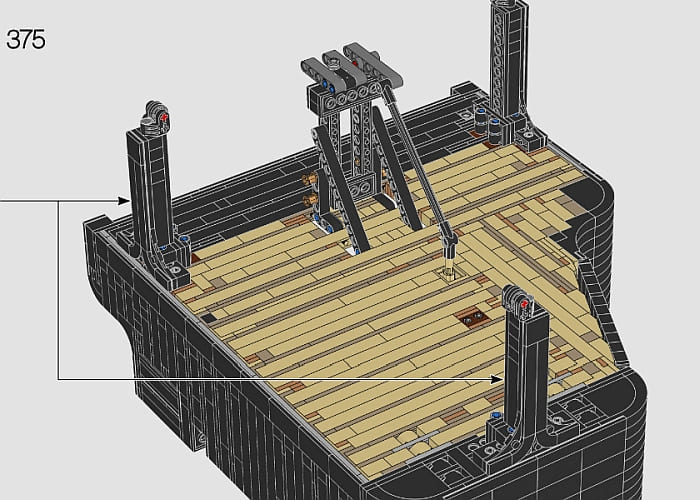
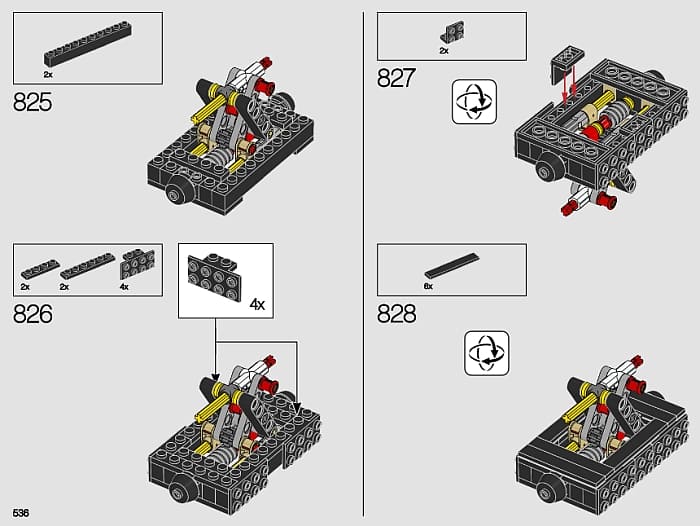
The three wheels at the bottom of the piano are all rotating and working casters (first picture above). This actually helps move the piano around since it is quite heavy. You also have a working fall-board that cover the keys and keep them protected from dust. The top of the piano opens, of course, with its stand. Though it is interesting to point out that the top has a section that can fold back allowing access to a built-in music stand. The music stand in question uses ridged slopes giving you the ability to lock the stand in at several angles. Oh, and the seat is adjustable (second picture above).
When people talk about bells and whistles, this set will be one that comes to my mind. If there were any meaningful features LEGO designers could add to the piano, they did. This is a fantastic example of how we should think when creating models with larger than average scales. And if all that wasn’t enough, LEGO designers even managed to incorporate Powered Up functions to bring sound to the model. So, let’s see how that is done.
LEGO IDEAS GRAND PIANO – HOW POWERED UP WORKS
Inside the piano is a LEGO Powered Up battery control box, a motor, and one sensor. Between these three components, they manage to offer two methods in how you can interact with the piano. You can either have it set to free play, which is where you choose any of the listed songs and, whenever you hit any key, it plays the notes of the chosen song in order. The effect is that you are playing the song. The other option is to have the app treat your model as a player piano. In this mode, while the song plays, various keys will be manipulated, giving the illusion that the piano is playing itself. So how does this all work?
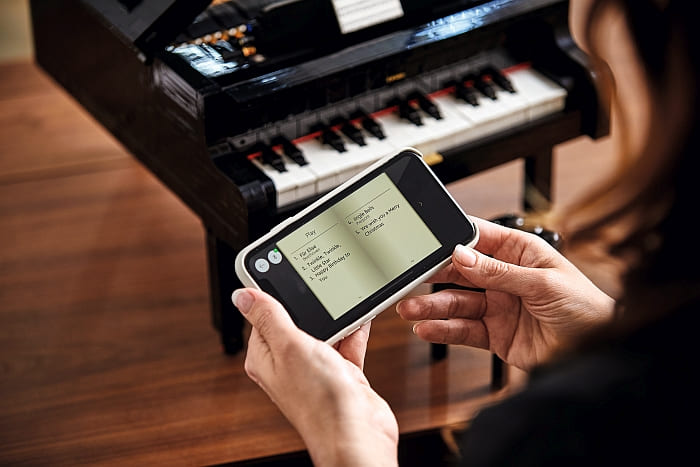
Believe it or not, the player piano is the simpler of the two. Under all the keys of the piano is a set of axles that have small lift-arms sticking out at various spots. These lift-arms come in three colors, red, blue, and white. All the lift-arms of the same color stick off in a given direction, so all the red will be on one side while another color is opposite them, and still a third color is pointing in a different direction. Axles come in a plus shape so you can position your average lift-arm in one of four directions. The fourth direction is left empty save for one thick lift-arm set off to one side, which is not under any key. We’ll get to this thick lift-arm later.
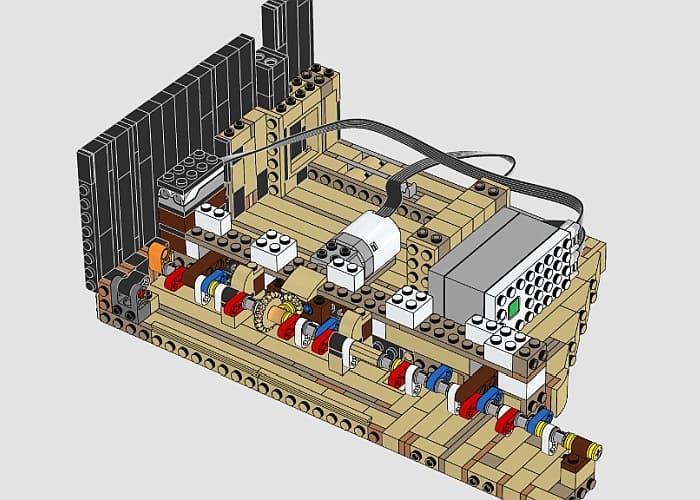
When the player piano feature is selected, the motor will then turn these lift-arms. Each time a lift-arm is in the up position, it pushes on the underside of a key thus pushing the key down from our perspective. Considering the lift-arms are spaced differently, this means different keys will look pressed as the whole contraption rotates. Meanwhile the app plays the song and everything looks like it is working together.
But is the free play mode that is even more interesting. Remember that thick lift-arm that sits off to one side? Well, a larger lift-arm rests on it. This is important since when it is in the up position it lifts this larger lift-arm in view of the sensor. This is how the LEGO Powered Up control box knows the keys can be pressed.
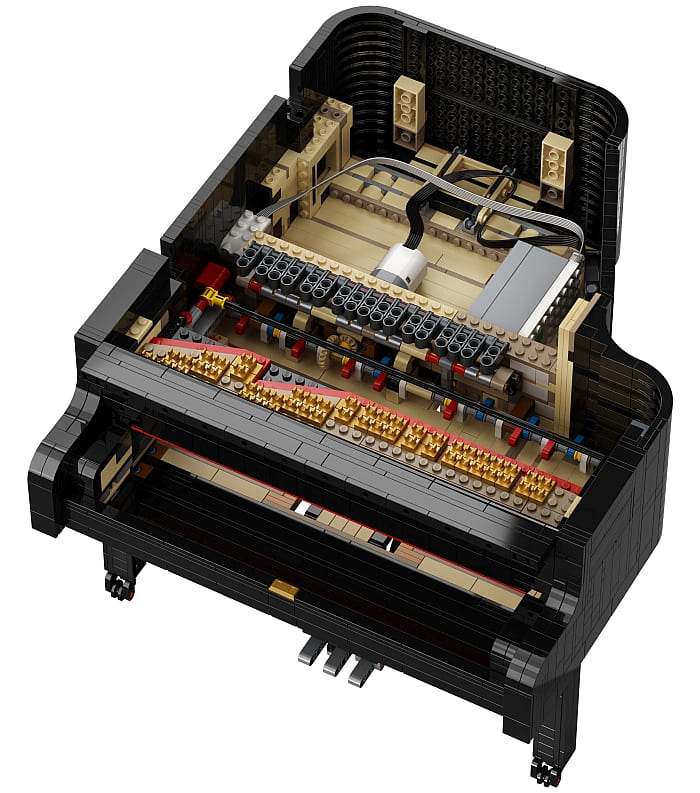
If you stop the player piano feature, chances are the keys will be in all sorts of pressed and not pressed states. You need to be able to press any and all of the keys to play with the piano properly. And since the thick little lift-arm is the only one sticking in that direction, it means none of the red, blue, or white lift-arms are in the way.
The motor will activate until the sensor sees the large lift-arm pushed up into its line of site. Now comes the next use of the sensor. All the keys on the keyboard have a plain axle resting right above them on the inside of the piano. This axle doesn’t do much of anything except move whenever a key is pressed. This means the connections that hold the axle in place also move up and down. They move enough so they come in sight of the sensor. The sensor then reports this to the app. The app in turn treats it as an activation command to play the next note in the song and thus you get the effect they wanted!
LEGO IDEAS GRAND PIANO – FINAL THOUGHTS
I know the #21323 LEGO Ideas Grand Piano set is above most people’s budgets, but it is honestly interactive art. The variety of classic songs alone in the app gives it some serious classic music credibility. Additionally, the elegant styling of the model is both iconic and striking.
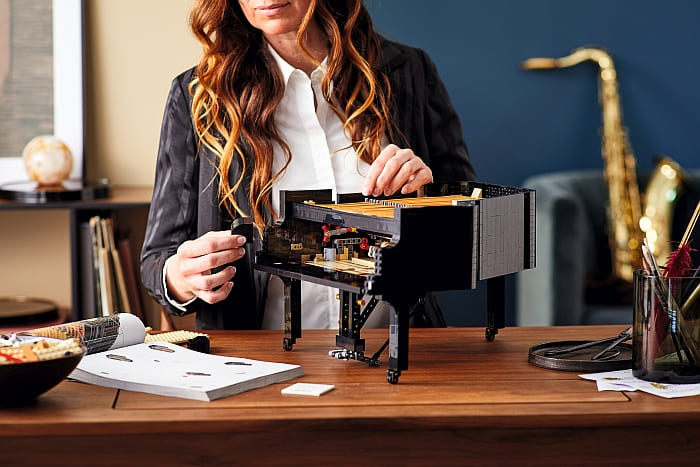
Build wise, this set was also a treat. LEGO designers have you constructing parts of the model in every direction, which kept the whole process interesting from start to finish. And even the tile serving as the sheet of music as well as the LEGO lettering on the underside of the fall-board are printed, so you don’t have to mess with stickers. All in all, the build was both challenging and entertaining.
And this says nothing about the play capabilities after it is built. I can see those without any musical experience enjoying it just as much as those who are classically trained. It truly is a model for everyone.
The only point against it is the price. $350 USD is a lot to ask for anyone to spend on a set. However, you do get your money’s worth. If you are on a tight budget, I’d recommend saving up for this one and treat yourself to an experience like none other for that very special occasion. For me, I surprised my wife on her birthday. We had recently put together the #21327 LEGO Ideas Typewriter, which got her excited to maybe save up and get the #21323 LEGO Ideas Grand Piano.
Little did she know I already had it tucked away for her. We weren’t sure what could follow the Typewriter in terms of a cool model with a great building experience, but the piano hands down beat it. It is not cheap, but it sure is quality!
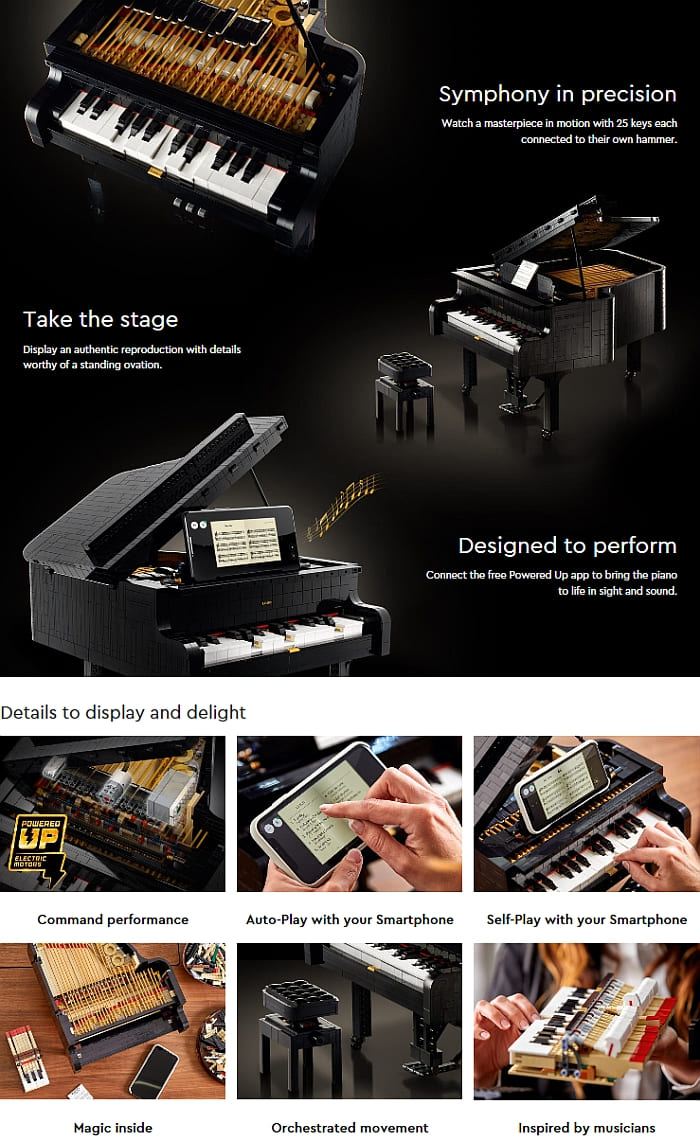
What do you think? How do you like the LEGO Ideas Grand Piano? Do you have it already? And what do you think of the features and techniques we discussed here? Feel free to share your thoughts and discuss in the comment section below!
And you might also like to check out the following related posts:












Are the videos not working? They just show up as a gray screen for me.
Martin, they are working fine, but for some reason the cover images don’t show up. Just hit the red play button and they will play. I will look into it later why the cover images aren’t showing.
They play fine for me. Thanks for the excellent review.
Thank you. Really appreciate the videos.
I like to read different perspectives, so it’s cool that two of you reviewed the piano. I’m especially impressed by the interior. It’s almost as packed as a real piano. lol
How long does it take to build a set this big? I found that my attention span last for maybe 3-4 hours, after that I get bored or frustrated, or both.
Some people take a break from building big sets after a few hours, and get back to the building table a later day, I have heard.
It’s incredible how far Lego has gone in just the past 20 years. People didn’t even dare to think about Lego releasing sets like the piano and the typewriter and the numerous other huge sets. I have to start to cut back though as I’m running out of space. Organization is starting to become a problem too. I have been thinking about hiring a kid to do it for me.
Notwithstanding Lego, organization remains a major issue for me… =/
Is the inside with the keys and strings all one unit? Is it removable like that? To me, that’s the most interesting part.
The keys move up & down but the only sound I get comes from my phone …though it shows that the blue tooth is connected to the piano hub. What should I do to rectify this?
The axle will only make one rotation then stops. The light on the motor blinks blue-orange-orange. How do I fix this?